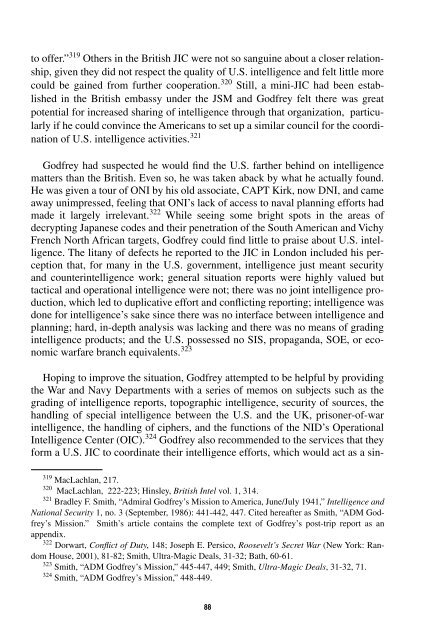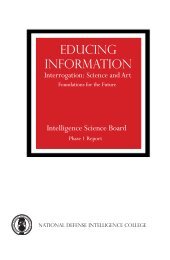emanating from Japanese home waters and were eager to obtain the greater volumeof signals the U.S. could provide them for analysis. 313 A formal agreementwas reached whereby a special radio circuit would be used to share informationusing a one-time pad code for the security of the transmission. 314 Hardcopy trafficand detailed analyses were sent using a regularly scheduled flight from Manila toSingapore. 315 Given the success of these exchanges, the U.S. Army attaché inLondon, in late May 1941, made a request to the British government, on behalf ofthe War Department, requesting a full exchange of intelligence information in theFar East. During a 6 June 1941 meeting of the British JIC, the British reached adecision to share all their intelligence in the Far East, except their SIS and SOEoperations, with the Americans. 316 Although this was a significant offer on thepart of the British, it was a difficult policy to implement, despite its having beenenacted at the request of the American government. As Richard Aldrich hasobserved, the U.S. had no comparable inter-service intelligence organization thatthe British could deal with, so every agreement needed to be worked out betweenindividual departments of the U.S. government. 317 Alan Bath has also noted thatthe U.S. was slow to respond to Far East initiatives as the threat there seemed lessurgent and many in leadership positions were still wary of any British desire tomaintain their colonial empire. 318 Both Aldrich and Bath are correct in pointingout that perennial problems in the relationship between the two countries existedas late as the summer of 1941 and continued to work against better cooperationon both operational and intelligence matters.The Godfrey Visit—May-June 1941In parallel with the effort to improve intelligence cooperation in the Far East,the JIC in London was still interested in ways to improve the cooperation andcoordination of U.S. and UK intelligence in the Atlantic theater. To this end, Godfreywas dispatched on a mission from the JIC to assess the state of U.S. intelligenceand, as Donald MacLachlan has stated, “to persuade the Americans to pooltheir intelligence with ours [the British], to adopt those of our methods which hadbeen proved by nearly two years’ experience and to accept all we were prepared313Smith, Ultra-Magic Deals, 79; Worth, 106-107314Stripp, 148; Aldrich, 80; Smith, Ultra-Magic Deals, 82; Worth, 105.315Smith, Ultra-Magic Deals, 82.316Best, 146-147; Aldrich, 80; Bath, 163-164.317Aldrich, 80-81.318Bath, 159.87
to offer.” 319 Others in the British JIC were not so sanguine about a closer relationship,given they did not respect the quality of U.S. intelligence and felt little morecould be gained from further cooperation. 320 Still, a mini-JIC had been establishedin the British embassy under the JSM and Godfrey felt there was greatpotential for increased sharing of intelligence through that organization, particularlyif he could convince the Americans to set up a similar council for the coordinationof U.S. intelligence activities. 321Godfrey had suspected he would find the U.S. farther behind on intelligencematters than the British. Even so, he was taken aback by what he actually found.He was given a tour of ONI by his old associate, CAPT Kirk, now DNI, and cameaway unimpressed, feeling that ONI’s lack of access to naval planning efforts hadmade it largely irrelevant. 322 While seeing some bright spots in the areas ofdecrypting Japanese codes and their penetration of the South American and VichyFrench North African targets, Godfrey could find little to praise about U.S. intelligence.The litany of defects he reported to the JIC in London included his perceptionthat, for many in the U.S. government, intelligence just meant securityand counterintelligence work; general situation reports were highly valued buttactical and operational intelligence were not; there was no joint intelligence production,which led to duplicative effort and conflicting reporting; intelligence wasdone for intelligence’s sake since there was no interface between intelligence andplanning; hard, in-depth analysis was lacking and there was no means of gradingintelligence products; and the U.S. possessed no SIS, propaganda, SOE, or economicwarfare branch equivalents. 323Hoping to improve the situation, Godfrey attempted to be helpful by providingthe War and Navy Departments with a series of memos on subjects such as thegrading of intelligence reports, topographic intelligence, security of sources, thehandling of special intelligence between the U.S. and the UK, prisoner-of-warintelligence, the handling of ciphers, and the functions of the NID’s Operational<strong>Intelligence</strong> Center (OIC). 324 Godfrey also recommended to the services that theyform a U.S. JIC to coordinate their intelligence efforts, which would act as a sin-319MacLachlan, 217.320 MacLachlan, 222-223; Hinsley, British Intel vol. 1, 314.321 Bradley F. Smith, “Admiral Godfrey’s Mission to America, June/July 1941,” <strong>Intelligence</strong> and<strong>National</strong> Security 1, no. 3 (September, 1986): 441-442, 447. Cited hereafter as Smith, “ADM Godfrey’sMission.” Smith’s article contains the complete text of Godfrey’s post-trip report as anappendix.322 Dorwart, Conflict of Duty, 148; Joseph E. Persico, Roosevelt’s Secret War (New York: RandomHouse, 2001), 81-82; Smith, Ultra-Magic Deals, 31-32; Bath, 60-61.323 Smith, “ADM Godfrey’s Mission,” 445-447, 449; Smith, Ultra-Magic Deals, 31-32, 71.324 Smith, “ADM Godfrey’s Mission,” 448-449.88
- Page 1 and 2:
COURTING A RELUCTANT ALLYAn Evaluat
- Page 4:
The Joint Military Intelligence Col
- Page 8 and 9:
FOREWORDTo most Americans alive tod
- Page 10 and 11:
PROLOGUESince World War II, the Uni
- Page 12 and 13:
Chapter 1THE STATUS OF INTELLIGENCE
- Page 14 and 15:
action, a propaganda unit, or an ec
- Page 16 and 17:
officers assisted by 20 civilian cl
- Page 18 and 19:
ships in violation of treaty limits
- Page 20 and 21:
assessments. By 1941, ONI was releg
- Page 22 and 23:
might bear on their work.” 39 As
- Page 24 and 25:
ility over time, its operational in
- Page 26 and 27:
Chapter 2U.S.-UK RELATIONS, 1914-19
- Page 28 and 29:
told by the Chief of Naval Operatio
- Page 30 and 31:
ups of the early 20th century. 65 T
- Page 32 and 33:
firmly believed that British polici
- Page 34:
ecame one of the primary sources of
- Page 37 and 38:
of shoring up their strategic weakn
- Page 39 and 40:
mon framework for negotiation with
- Page 43 and 44:
assuaged British concerns about the
- Page 45 and 46:
In the area of intelligence exchang
- Page 47 and 48: clear to the Americans that if they
- Page 49 and 50: in his mind worked against closer c
- Page 51 and 52: praised the fighting spirit of the
- Page 53 and 54: through November of 1940 persuaded
- Page 55 and 56: and Great Britain. His principalcon
- Page 57 and 58: eceived by the British and from the
- Page 59 and 60: gear designed by the British. Altho
- Page 61 and 62: American Attitudes On Intelligence
- Page 63 and 64: information did have an impact on K
- Page 65 and 66: the affair. 183 This lack of resent
- Page 67 and 68: tion exchanges. Even more significa
- Page 69 and 70: nation (BSC) mission, is now availa
- Page 71 and 72: good will and encouraged greater co
- Page 73 and 74: would merely show Donovan “the be
- Page 75 and 76: Lothian passed Hill’s proposal to
- Page 77 and 78: still a powerful influence. While Z
- Page 79 and 80: Since the Tizard Mission had only a
- Page 81 and 82: appropriating large increases to th
- Page 83 and 84: the French, a point which would not
- Page 85 and 86: equested that RADM Ghormley remain
- Page 87 and 88: when he [Pott] comes to O.N.I. he i
- Page 89 and 90: it was not official U.S. policy. St
- Page 91 and 92: efforts that had begun with the Sta
- Page 93 and 94: high-level ABC-1 staff talks which
- Page 95 and 96: to successfully interpret the instr
- Page 97: to little more than a nebulous stat
- Page 101 and 102: Operational Intelligence Cooperatio
- Page 103 and 104: Godfrey’s main concern was most l
- Page 105 and 106: possesses complementary capabilitie
- Page 107 and 108: 2. Be prepared to give something of
- Page 109 and 110: had in forming its own Joint Intell
- Page 112 and 113: GLOSSARYABC-1ALUSNALondonBGENBSCCAP
- Page 114 and 115: APPENDIX AA NOTE ON SOURCESArchival
- Page 116: APPENDIX BMAJOR EVENTS IN U.S.-UK I
- Page 119 and 120: ________. Foreign Relations of the
- Page 121 and 122: ________. “The Secret of the Chur
- Page 123 and 124: Zacharias, Ellis M., CAPT, USN. Sec
- Page 126 and 127: INDEXAABC-1 Talks 41, 57, 74-75, 78
- Page 128 and 129: IImagery Intelligence (IMINT) 12, 8
- Page 130 and 131: Signals Intelligence(SIGINT) 2-3, 7
- Page 132: PCN 53512ISBN 0-9656195-9-1
















